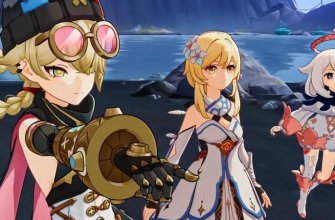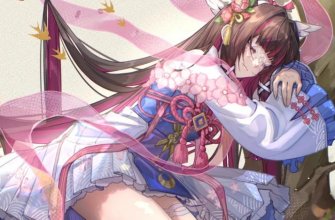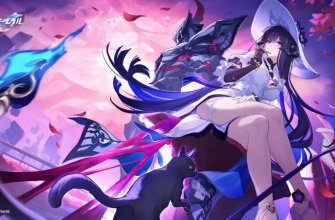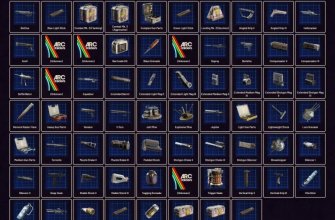The game Gems of War is stunning in its depth. It’s not just a 3-in-a-row game, although that’s the mechanic most of the time. It’s a huge world, with lots of heroes and possibilities. In the game, you can not only collect cards, but also develop them, participate in guild events, and more. To make it easier for new players to get the hang of it, you should read this beginner guide for Gems of War, then much will become clear, and especially how to start playing Gems of War.
Beginners Guide Gems of War
Buy dragon armor
The most important thing a novice player must do is purchase dragon armor, which gives a 100% increase in gold collected, and a 50% increase in souls and experience gained. You can purchase and put it on in the hero’s menu under the “Style” tab. After acquiring this armor, go to the “Armor Bonus” tab and make sure to select it. The dragon armor costs 500 diamonds, so if you don’t have enough, you should wait until the beginning of next week when the Guild completes blue tasks, which will bring you 390 diamonds.

Dungeons
If you’re new to the game, your first task is to unlock the Dungeon by completing an adventure in the kingdom of Wandering Sands. Battles in it can be quite difficult, but defeating at least the first of three battles will give you access to the purchase of the Stone Scrolls. You can buy it by clicking on the purple “Offer” button in the upper right corner of the Dungeon window and then clicking on the “Rock Placer” tab in the window that opens. Every day a new placer appears in the Dungeon, and their regular purchase will allow you to collect gems and diamonds needed for forging weapons and mythical cards in the Soul Forge faster.
The Forge of Souls
The Forge of Souls opens even before the Dungeon after you’ve had an adventure in the Kingdom of the Poisoned Lands. Its level determines what you can forge in it. To raise her level, you must defeat a certain number of cards in battles. Remember that you have to manually raise the level by filling the counter of the killed cards, and only after that the counter for the next level will begin to accumulate. Raising levels for diamonds is a waste of resources.
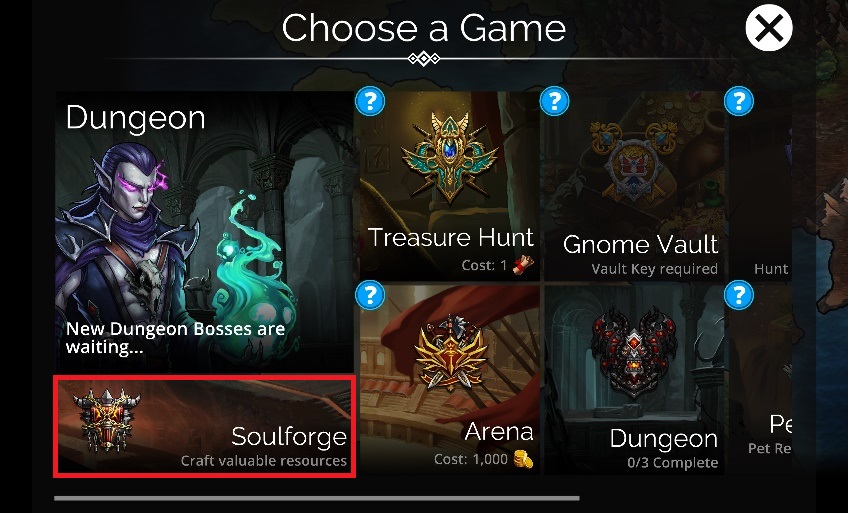
The priority should be forging rare weapons. Since it costs gems and diamonds, it is better to check with more experienced clan players whether it is worth forging a particular weapon available in the Forge this week. Some of the definitely useful items are Life and Death, Rascal Shot, Eye Jar, Tree Crystal, Flesh Breaker, Norbert’s Turnip, Dart-on-a-Loop, and Graveyard Secrets. Trouble guns, the most powerful weapon in the game, it is advisable not forge, and buy during the event Tower of Trouble for the diamonds in the event store (during the campaign event with the troubles are not, so forge them can and should!). And not every event. In fact, there are only six pieces of Trouble that transform stones into fatal skulls and deal damage: Doomed Glaive, Blade of Trouble, Club of Trouble, Crossbow of Trouble, Doomed Scythe, Doomed Axe.
Forging legendary cards for 800 diamonds is highly discouraged. Only mythic cards worth 4,000 diamonds are worth consideration. The first priority are Arachnid Weaver, Obsidius, Supreme Iron King, Megasaurus, and Mythic Kingdoms of Magic to achieve their 10th level of power. Some useful myths include Phoenicia, The Wild Queen, the Gray King, TINU-9000, and several others.
Underworld
After completing the adventure of the kingdom of Sin Marajah, you will open the Underworld. You can get there by clicking on the cross with the signature “Cristara”, which you usually collect tribute from the kingdoms by clicking on it. The Underworld is made up of many so-called Factions. Each faction is tied to a specific kingdom on the surface (you can tell by its unique maps). There are races available – a series of 8-9 battles, at the end of which you receive a reward; you can only have three races per day, regardless of which faction you spend them in. A special feature of the heats is that each subsequent battle starts in the composition and formation that you had at the end of the previous battle, so losing cards in battle is not recommended. The main advice for beginners is to choose one faction as your main one, and as you play improve its treasury up to quality level 10. By doing so, races in that faction will bring you the most resources.
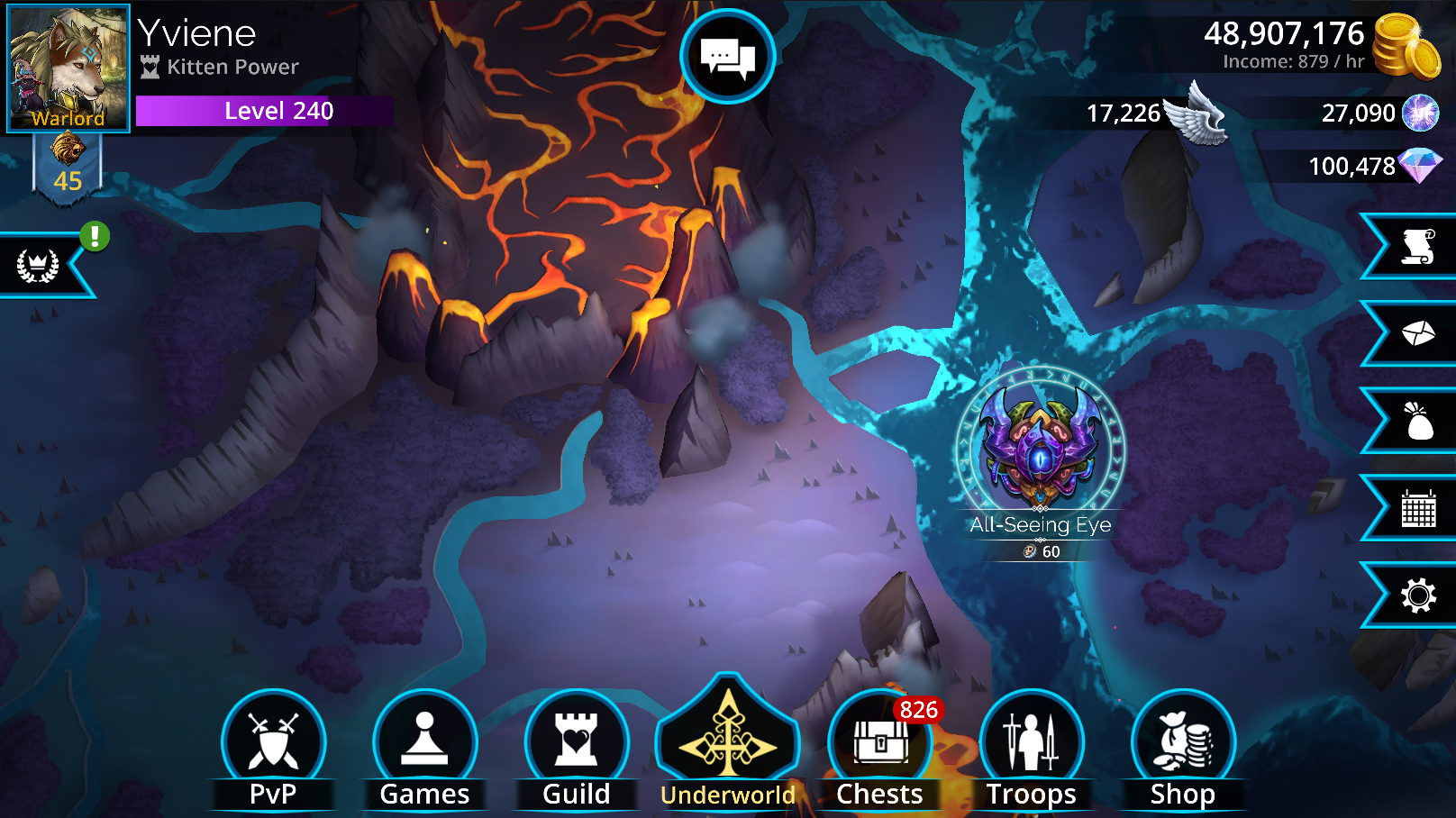
Playing in factions you will receive Chaos Shards. For these you can open portals of chaos in any of the available factions. For these you will receive treasure, which is needed to improve the faction treasuries, as well as unique cards. Each faction has four of them. The first place you should go when you open the Underworld is the Deep Hive, and it is in its portals that you can obtain the Queen Bee-liatrix.
Urskograd Shield
Once you have unlocked the last kingdoms, including Urskograd, you should take its class test for a Sentinel and play it 250 battles to obtain the Urskograd Shield. This wonderful weapon will allow you to play the “Ruby” build (see the same section of the site with map builds), which will facilitate your further development. Other class weapons you should get hold of early:
- Steal-Kill (Corsair class, Black Label kingdom) – to play in a build with two Cedric Sparkrosums and Egg Thief, allowing you to collect huge amounts of gold when passing expeditions;
- Essence of Evil (Lord of the Plague, Rock of Gloom) – a terrifying weapon often used in pvp fights;
- Eye of the Dragon (Dragon Guardian, Dragon Claw) – to play paired with the Supreme King of Ironbelly, which allows you to easily take 500 levels of the faction of the Underworld;
- Harvest of Sin (Soothsayer, Sin Marajah) – an economy version of Doom Scythe, transforms yellow stones into fatal skulls, and deals minor damage to all enemies.
Upgrade the kingdoms (important!)
In parallel with the opening of the kingdoms you can start to pump them up. Your first goal is to level up all the kingdoms to level 10. During this period newcomers are exempted from the obligation to contribute gold to the Guild tasks, moreover, the latter is not recommended. Level 10 of a kingdom gives you a bonus to the parameter, which is different for each kingdom. First of all, you should pump up the kingdoms with a bonus to magic, these are Zul’Kari, Karakot, the Rock of Darkness, Poisoned Land and Silver Glade. After that, you should raise the kingdoms with an increase to attack, health and, finally, armor in order of priority.
When all kingdoms are level 10, further increases will require gifts. These accumulate very slowly, so use them wisely. It is always a good idea to put all donations of the same color into the same kingdom until it reaches level 15. The first green kingdom at level 15 is Zul’Kari, in order to get a +1 magic bonus.
The second (and parallel) stage of pumping the kingdoms is to raise them all to level 5 power. The hardest part of this is pumping all three skills on any 7 kingdom cards. To simplify the process, you can pump the skills of the youngest kingdom cards, as this requires a minimum number of stones. Growing the power gives an increase in both quantity and chance of tribute rolls (including keys of gold and diamonds), and level 5 gives a +1 increase to the kingdom parameter. The logical consequence of this is that kingdoms with a magic boost should be the first to gain power, followed by those with an attack, health, and armor boost, respectively.
At the end of this stage, you usually have quite a few copies of cards and can start thinking about 10 power in magic kingdoms. If you have a tri-color mythic card of such a kingdom, you are good to go. First, you should pull out all four faction cards of that kingdom in such quantity that they become mythic. This is to make it easier to get the 18 level 20 cards you need for 10 power.
Resources (important!)
There are several types of resources in the game.
Gold
Gold is used to level up kingdoms and faction treasuries, guild quests, and more. The main sources of gold are PVP battles (the most profitable type of combat in the game), medium and high-level expeditions, faction races. Additional gold can be obtained by playing the assembly with Cedric Iskrosum and Skeleton Key.
Souls
Souls are needed to level up cards and classes, as well as to craft items in the Soul Forge. For beginners, the fastest way to obtain such scarce souls is the Arena, which can be found in the “Games” menu. With the opening of the Underworld, a good influx of souls will ensure that races in the factions will take place. You can also use a special soul crafting build, consisting of a hero with the weapon Fial (given when you reach skill 19 of purple and blue mana), and three cards with the skill “Necromancy” pumped. There are a lot of these cards, the easiest way to find out which ones you have is by typing the word “Necromancy” into the search box on the troop menu. The most convenient way is to play her 1 level expeditions, at the same time you farm master stones and get at least 180 souls per battle (with dragon armor on), a total of 900 souls per expedition.
Fame
Fame (wings) is mainly used to buy event cards (in the Shop menu on the Event of the Week tab) and to buy Fame Keys in the Chests menu. The main sources of Fame are PvP battles (you will also receive an additional 275 wings and 46 Fame Keys for increasing your PvP rank to level 1), faction races and tribute from the kingdoms.
Diamonds
Diamonds are quite a scarce resource, the main sources of which are blue Guild quests, tribute from the kingdoms, rewards from all kinds of events and occasional errands. After acquiring dragon armor, the main expenditure of diamonds should be the daily purchase of placers of stones in the Dungeon (350 diamonds per week), and on the remaining – purchases in the stores of the events (bosses, sieges, towers of woe, attacks on the faction, baiting, etc.), as well as the strengthening of sentries during the guild war. Spending diamonds to store for events such as Pet Rescue and Class Trial is not worth it. As the power of the kingdoms increases, so will the number of diamonds you get with tribute, and quite significantly. Keep in mind that tribute is not accumulated, but randomly generated, and once collected, the next tribute will be ready in an hour. So if possible, check back into the game more often for this purpose.
Master Stones
This resource is needed to pump up the skills of cards and classes, and you need just a sea of them. Special type of battles, designed for mining masterstones, are expeditions. If you need to get small or large stones quickly, your choice is level 1 of expedition, runic masterstones are easiest to get on level 5 of expedition (good to combine with builds with Cedric (with one or two) and Steal-Kill/Skeleton Key for gold mining in passing). Mystic masterstones are best mined at level 12 of the Expedition. Celestial ones are occasionally dropped in expeditions, pvp and some other battles.
Spheres
This is not even so much a resource as a bonus.
Large growth spheres (green) make sense to spend on legendary cards and above. Small ones are good to spend on the last level of the expensive cards. For example, after an upgrade of a legendary card to a mythic, a small growth sphere will save 1000 souls for an upgrade from level 19 to 20.
Spheres of wisdom
Spheres of wisdom are worth spending to buy expensive skills from cards and classes. It never makes sense to spend them on the first skill. The same can be said about their use of cards below Epic level. For epic and legendary cards and classes it makes sense to raise only the second, most expensive skill, for mythic – the second and third.
Spheres of elevation
Spheres of elevation (important!) is not worth spending at first, they are useful for the elevation of Guardians (these are 12 cards, falling out only from the Guild coffers). If all 12 guards become mythic and each guard has at least 4 copies, the guards stop falling out of guild chests, doubling the chance of mythic cards falling out of them (the standard 2000 seals are 100 chests, which, once the guards stop falling out, are equivalent to 110 diamond keys in terms of the chance of falling out a mythic). Large orbs of elevation are worth spending on the guards with the lowest level of elevation, which is quantitatively the fewest than any other guards. Small ones are worth spending on the guards that reach Legendary (orange) level. After all the guards are mythics, forget about the blue spheres, because it’s time to save up for Zuul-Goth.
Guild
A little bit about things inside the Guild. Each team member is expected to do just three things: regularly collect guild seals, do your best to complete quests (once you’ve built all the kingdoms to level 10), and participate in all guild events (sieges, towers of woe, bosses) and, especially, guild wars.
Seals are collected in the “Seals” tab of the Guild menu. It is advisable to go there at the end of each day and click on the “Collect All” button to have them added to your weekly total Guild score. The total score has a maximum value of 40000, on reaching which you can open guild chests (they are in the same menu where you open keys of gold, glory, etc.). Opening guild chests before the guild has accumulated 40000 seals is not recommended, as the rewards will be strikingly different not for the better.
There is also a “Use Sphere” button in the Seals menu that allows you to convert a small or large clan orb into seals if you are lucky enough to obtain them. It’s a good practice to use clan spheres when it’s suggested in the Guild chat announcement in order to get the missing seals (important for young guilds, in which getting the right number of seals is a problem). If the Guild has already reached the maximum amount of 40000 seals, the spheres are used at their own discretion.
Guild quests are performed in the Guild tab of the same name on the Guild menu. Blue tasks have the highest priority, they are always executed first. The second highest priority are purple and red tasks. Next are the other three basic tasks. It is desirable not to perform tasks chaotically, but one by one, in order to complete as many of them as possible. For fully completed tasks, all members of the Guild receive a bonus to a certain parameter for a week. Upon completion of the base, the first performed green epic quests, as the most valuable because of obtaining scrolls that allow to forge such scarce gift magic (up to 6 pieces per month when performing green epics weekly), as well as purple epic quests based on similar considerations.
Classes
Best classes
The first class to start pumping methodically is Titan (Stormheim). Its key advantages are starting hero with 50% mana, “Aura Storm”, “Like a Rock”, “Lightning Strike/Bloodlust”, “Fortitude” talents, as well as a lot of life (at the expense of armor, though). The class is almost universal, for expeditions, races, events, etc. He has interesting alternatives in the form of the Watchman and Monk, but they are somewhat more specific. Prokachivat needs to reach level 100.
The second extremely useful class is the Ice Mage (Ice Mountain). He has a lot of useful talents, but the most valuable one is freezing a random enemy at the beginning of the fight, as well as a 25% chance to freeze one of the enemies when an ally casts a spell. This makes it great for stopping carousel builds, such as goblins. Upgrade enough up to level 70.
A useful class is Thief (Zaedjin), which, being armed with Norbert’s turnip, is needed to play assemblies of those very goblins. This class is also great for builds with Cedric and Steal-Kill/Skeleton Key. Upgrade preferably to at least level 70.
Also worth looking at is the Stormbringer class (Sunny Ridge). Great for playing with yellow teams, thanks to the skill that causes a storm of light every turn of the hero. And in the company of three pumped Finesse (one of the Guardians), will fall under their third skill, as the hero will be a streamer. It makes sense to pump up to at least 70.
Spear of the Sun, like Stormbringer, also cause a storm at the beginning of each turn, but fire instead of light. A class regularly used during Guild Wars, both offensively and defensively, being the best option for red builds (like with Yao Guai or Phoenicia). Has extremely useful talents, the last of which, Flaming Blade, allows you to use it in a build with Zuul’Goth: the boss kills the enemy, sets fire and freezes the rest, creates a bunch of skulls, and the hero deals triple damage with the skulls set on fire.
Lucky owners of the Arachnid Weaver and Life and Death weapons will need the Spinner class (Zul’Kari). This bugger entangles the first enemy at the beginning of the battle, is able to summon two types of storms at the beginning of the battle, and with a 35% chance summons a Giant Spider every time it receives damage, while also entangling a random enemy with its web when summoned. Requires a minimum level 70 upgrade.
Similar to the Ice Mage is the Lord of the Seas – although he has a freeze only at the start, but his third skill is similar to the talent Lightning Strike, only it is obtained at once. Plus it allows you to get a bonus to many kinds of mana to choose from. On top of that he has the Purification talent (cleanses the hero when he collects 4-5 stones). All of this makes him a very flexible and handy class.
Other useful classes are:
Archer – for green builds, starts with 50% mana, throws hunter tags, entangles at the start. But it is controversial to get his third skill, allowing a high chance to kill the enemy when hitting with skulls, because it cuts points in the Guild Wars;
Monk – for the assembly, where the main role played by the hero. Hero will have a bunch of different resilience, talent cleansing, Like a rock, as well as the talents of Fertility and Good karma (gives the hero 3 mana when collecting 4-5 stones);
As well as Dervish (for builds with monsters), Mechanist (for builds with mechanisms), Strangler (for killer builds with Zuul’Goth) and others.




